 |
|||||
|
|||||
| Preview of Stamps Catalogue: VOLUME 1 |
 |
|||||
|
|||||
| Preview of Stamps Catalogue: VOLUME 1 |
Return To Catalogue - Newfoundland, forgeries of the second issue - Newfoundland - Canada
Note: on my website many of the
pictures can not be seen! They are of course present in the catalogue;
contact me if you want to purchase it.

Genuine 5 p stamp with forged cancel.
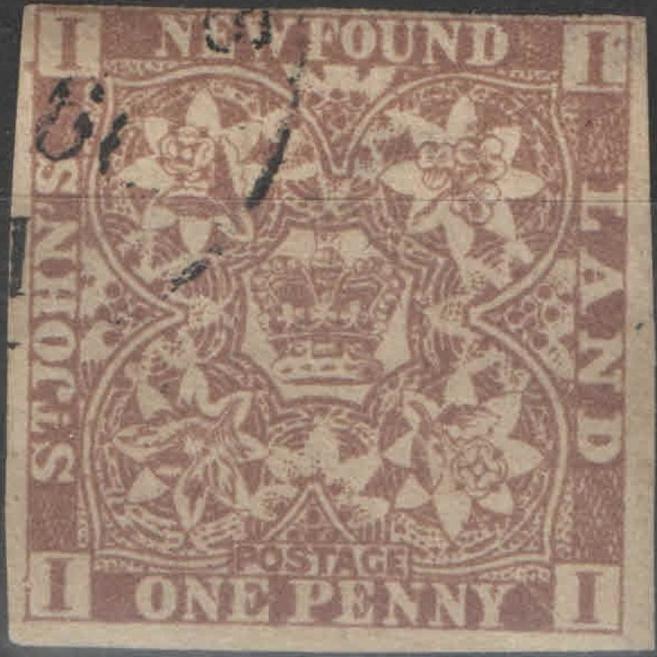

It appears that the first forgery has a "Correos
7.1.60. II-III" cancel?
Distinguishing characteristics of this forgery:
1) The 1 p and 5 p should have 7 pearls in the
left side of the crown, the above forgery only has 6 pearls!
2) The dot under "T" of "ST" is very small,
in the genuine stamp it is quite big.
3) The apostrophe behind "JOHN" is different from the
genuine stamp
This is the first forgery described in Album Weeds. I've seen in it many colour shades ranging from light brown to lilac. I've even seen it perforated! Is the next stamp from the same forger?:

Crude forgery with inscription "FIVE PENNY" instead of
"FIVE PENCE".

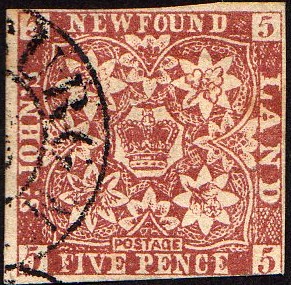
This forgery of the 5 p value has a German cancel "OLDENBURG
3 N". The '5's in the corners are much smaller than in the
above Spiro forgery
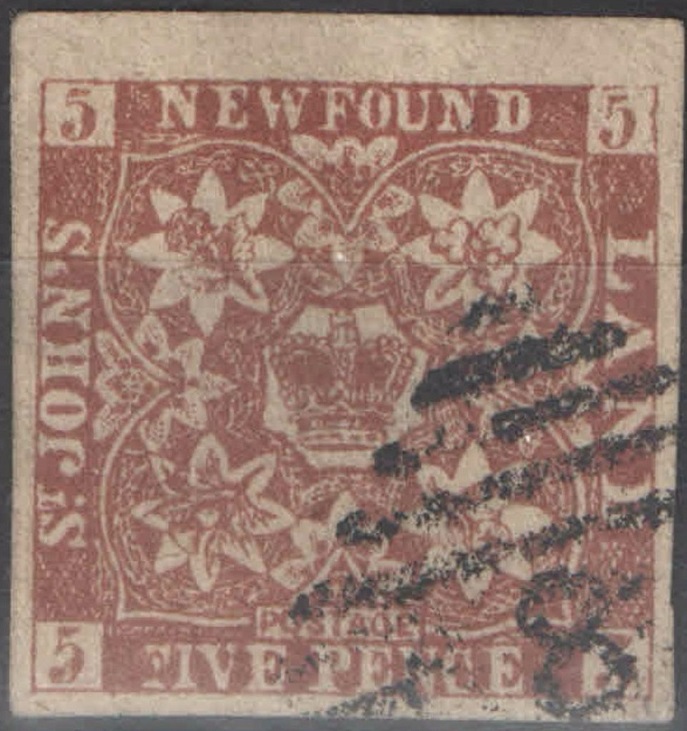
Here the same forgery with an "8"
numeral cancel as exist on forgeries of many other countries.
More dangerous engraved forgeries exist, all with the wrong number of pearls in the crown (according to 'The forged stamps of all countries' by J.Dorn), such as the following Oneglia forgeries:
Oneglia forgeries: Note that they are cancelled with a grid "8" cancel. According to the journal BNA Topics (May, 1972 page 116), in an article called 'The Panellis' by E.A.Smythies, this forged cancel has two unbroken lines besides the "8", while the genuine cancel only has one such line. The genuine cancel "8" belongs to Chatham New Brunswick(!). The "J" of "JOHN" has a tail that is not present on a genuine stamp. Also the engraving is too well done.
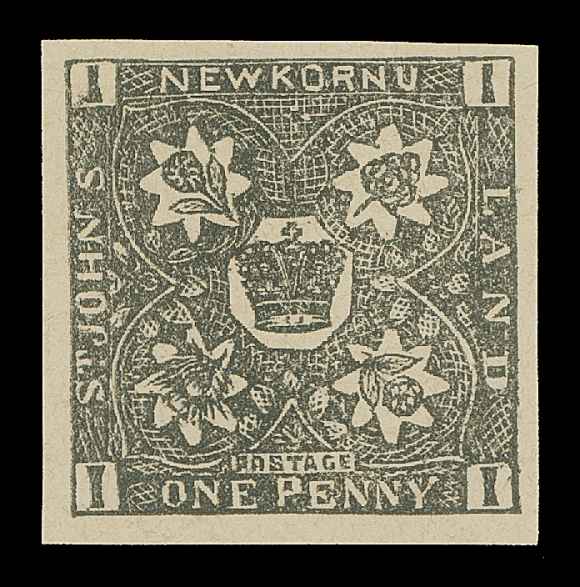


Some peculiar forgeries with inscription "NEWKORNU
LAND" in various colours. The back has the inscription
"1892 Y.Fr-edl', according to
http://www.easternstamps.com/images%5CPublication_FLd.pdf, this
is probably the famous Austrian forger Sigmund Friedl, who made
other bogus stamps around that period.

(probably genuine)
In the genuine stamp, the word "NEWFOUNDLAND" is one word.



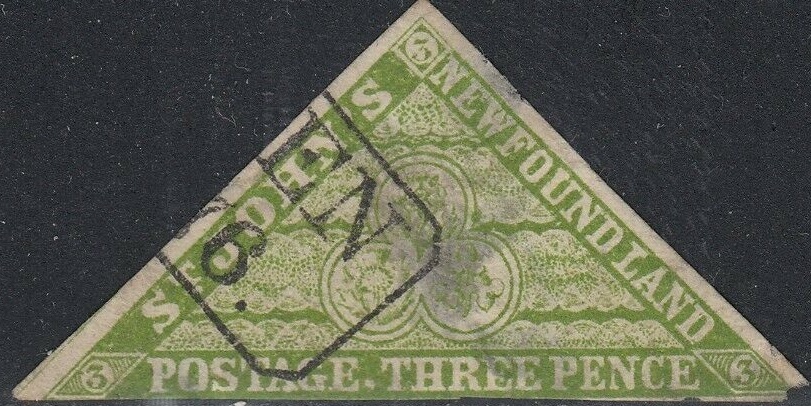
With a German "DRESDEN 10 1. 76." cancel? This forgery
appears to have a lighter tone of green than the previous darker
green forgeries.
Distinguishing characteristics of this Spiro forgery:
1) The cancels are typical 'Spiro' cancels (a
wide variety of bogus cancels seems to have been used)
2) The word "NEWFOUNDLAND" has a larger space between
"D" and "L" than in the genuine stamps.
3) The "O" of "JOHN" is flat at the bottom
(in the genuine stamp it is rounded), also a diagonal dash can be
found in this letter at the lower right side.
4) The "O" of "POSTAGE" is also flat at the
bottom (genuine it is rounded)
5) The stamp is lithograped instead of engraved as the genuine
stamps
6) The network in the center has 3 empty spaces in it with almost
no lines (it is not as nicely done as in the genuine stamps)
7) There is an extra outline outside the stamps (this outline is
not present in the genuine stamps).
This is the forgery described in Album Weeds (there even seem to be two types of this forgery, differing in the network pattern). Many of these forgeries seem to have been made, in such an extent, that later examples show wear.
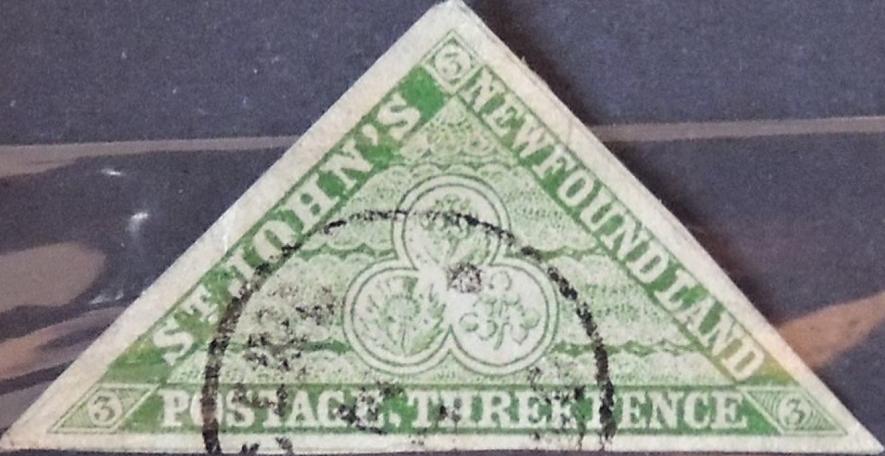

Here with a VF cancel which appears
on many forgeries of other countries.

(Reduced size)
1) The "J" of "JOHN'S" has a
spur at the right base.
2) There is an extra dark layer above the trefoil.
3) The background appears to be cross-hatched.
4) In this particular case it has a numeral "8" cancel
(which belongs to Chatham, New Brunswick!).
Other forgery:




Another forgery is shown above, the lettering is quite different
from a genuine stamp. For example, the "J" of
"JOHN" or the "S" of "POSTAGE".
Also, a primitive forgery with perforation in a very similar
design . The design of this forgery is identical to the image
given in "The illustrated catalogue of postage stamps"
by J.E.Gray (1870, page 126, third image). A similar image
appears in the catalogue of Placido Ramon
de Torres "Album Illustrado para Sellos de Correo"
of 1879 (information passed to me thanks to Gerhard Lang, 2016)
on page 226 (fourth image).
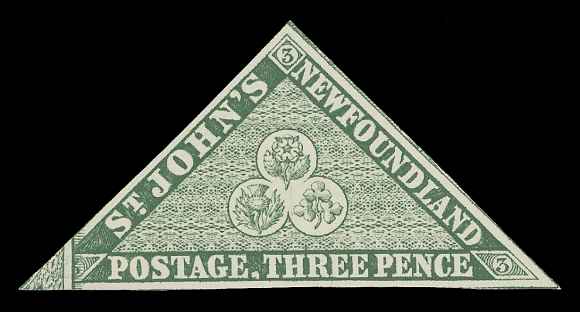
Cut from a Hugo Griebert advertisment card from 1919. The left
hand side actually had a green Chile stamp overlapping the
design.

A Hugo Griebert advertisement.
And another forgery in the wrong colour (grey instead of green):



Primitive forgery, note that the stem of the lower right flower
is pointing in the wrong (right instead of left) direction.
And a forgery in the color lilac:

Forgeries of Newfoundland with an "S" cancel.

Forgery of St.Helena with the same "S" cancel.
Some genuine cancels on genuine stamps exist, but with the cancel applied after the stamps were invalid. The cancel used is shown below. The '9' was inverted to become a '6' in '1864'. They were produced in the 1940's. The most common ones are St.Johns, but Grand Falls also seems to exist. They are sometimes accompagnied by a mute line cancel (as in the second example). Source: http://www.easternstamps.com/images%5CPublication_FLd.pdf. I've seen several dates. Some examples of these forgeries:
Stamp forgeries - Timbres-Poste faux - Briefmarken Fälschungen